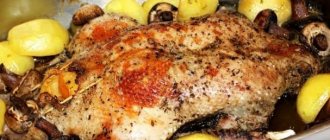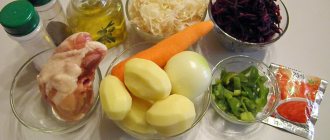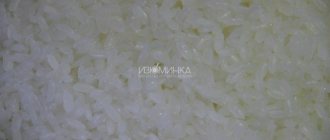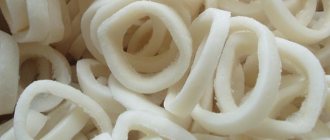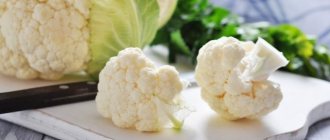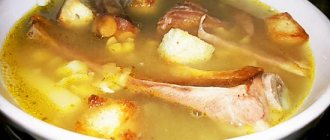What does this unusually shaped vegetable contain?
Squash, picked from the garden, contains a whole range of vitamins and minerals. Among them it should be noted:
- Squirrels.
- Fats.
- Carbohydrates.
- Water.
- Mono- and disaccharides.
- Cellulose.
- Organic acids.
- Pectins.
- Ash substances.
- Vitamins: A, B1, B2, B3, C, E, PP.
- Potassium.
- Calcium.
- Magnesium.
- Sodium.
- Phosphorus.
- Iron.
The product has a very low calorie content ( 18-19 kcal per 100 g ), which allows it to be used in the diet of athletes and people who dream of losing at least a few extra pounds.
Squash salad
Ingredients: 6 kg of squash, 1 kg of carrots and onions, 150 g of garlic, 1 glass of sunflower oil, 1 glass of table vinegar, 3 tbsp. l. salt, 4 tsp. ground black pepper, 2 cups sugar.
Preparation: wash the vegetables, peel and dry. Cut the squash into cubes and grate the carrots (for Korean salads). Cut the onion into half rings, pass the garlic through a crush. Place vegetables in a large saucepan, stir, add remaining ingredients. After 3 hours, place the salad in sterilized jars, place them in a large container with water to sterilize so that the water reaches the “shoulders” of the jars. Sterilize within 15 minutes after the water boils. Roll up the jars, turn them over, cover with a warm cloth.
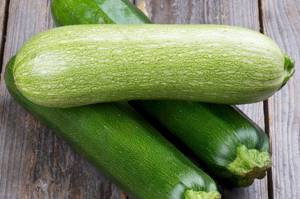
How is zucchini different from zucchini? More details
What benefits do squash dishes provide to the body?
Squash, which has firmly taken its place in the European cookbook, is not only a light dietary product. This vegetable, which in its raw form does not have a pronounced taste or smell, can have an invaluable effect on the human body.
In particular, it has the following actions:
- Reduces the risk of cancer.
- Prevents the development of atherosclerosis, ischemia, arrhythmia, stroke, heart attack.
- Promotes the process of losing weight.
- Eliminates inflammatory processes in the gastrointestinal tract.
- Neutralizes toxicoses of various etiologies.
- Lowers blood pressure.
- Normalizes the process of formation of new blood cells.
- Eliminates chronic constipation.
- Stabilizes the functioning of the gastrointestinal tract.
- Provokes the outflow of bile and normalizes liver function.
- Improves blood composition and strengthens the walls of blood vessels.
- Prevents nervous system disorders (insomnia, depression).
- Regulates the functions of the endocrine system.
- Stabilizes the water-salt balance, eliminates swelling.
- Enriches the intestinal microflora, eliminates dysbiosis.
- Facilitates kidney function.
- Eliminates migraine.
Like all plants from the pumpkin family, squash is included in the therapeutic diet for kidney and liver failure. And the presence of potassium and magnesium in it allows it to be used in the treatment of cardiovascular diseases.
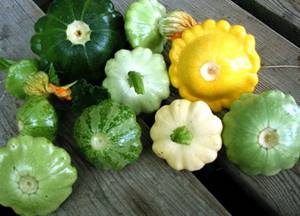
Squash: benefits and harms, what are the benefits of a vegetable for the human body, can it be given to children?
Squash - a plant of the Pumpkin family, has many varieties that differ in shape (disc, lantern), color (white, yellow, orange, green) and ripening time (early, mid-ripening, late).
Like many plants, they have several uses, but are most often used as food, having both positive and negative effects on the body.
In our material we will talk about the beneficial and medicinal properties of squash, in what form it is best to eat it, whether the vegetable can be given to infants and children under one year old, as well as contraindications to its use.
It is very important to choose it correctly, regardless of how it is planned to be used in the future.
Ripe squash:
- Glistens in the sun.
- Has a dry stalk.
- Should not contain dark spots or cracks.
- The size is not too big.
It has an orange color (such fruits are most useful due to the antioxidant lutein, which is not synthesized independently in the human body).
Composition, calorie content per 100 grams, nutritional value and glycemic index
Its chemical composition is varied; per 100 g of raw material it has the following elements:
- Dietary fiber – 1.3 g.
- Macroelements, for example, calcium - 13 mg, magnesium - 26 mg, phosphorus - 12 mg.
- Microelements: potassium – 203 mg, iron – 0.4 mg.
- Vitamins: C - 23 mg, PP - 0.3 mg.
- Organic acids – 0.1 g.
- Water – 93 g.
- Mono- and disaccharides – 4.1 g.
Calorie content of squash:
- Fried – 125 kcal;
- Stewed – 46 kcal;
- Cheese – 19 kcal;
- Nutritional value: proteins – 0.6 g, fats – 0.1 g, carbohydrates – 4.3 g.
Glycemic index is 75.
What are the benefits for the human body?
It has a positive effect on the human body and is considered a delicacy and dietary product.
The role of the impact of the beneficial properties of vegetables on the healthy body of men and women is as follows:
- Anti-cancer product. The substances in the product absorb free radicals.
- Slows down the aging process. Due to the high content of antioxidants, it promotes skin regeneration.
- Resists viruses and colds. By stimulating the production of antibodies, it supports the body's immunity.
- Taking care of your joints. Nutrients promote the production of collagen, preventing arthrosis.
- Useful for stress. Thanks to the vitamin C content, it helps the body produce the happiness hormones Dopamine and Serotonin.
- Needed by the heart muscle due to its potassium and magnesium content.
It is useful for pregnant and nursing mothers , but it must be consumed with caution and in small quantities, as it can cause diarrhea and skin rashes in the baby. Consumption in the form of freshly squeezed juice, fresh or canned is prohibited.
At what age can a child be given squash and is the vegetable harmful to children under one year of age? Children under one year old and infants receive nutrients from their mother's milk, so a lot depends on the woman's nutrition.
At the age of 4-5 months, babies can gradually introduce only squash puree into the diet in the form of complementary foods (no more than 100 g per day, starting with 0.5 tsp). It is better to use canned food. Attention should be paid to the child’s condition and well-being.
In case of side effects, discard the puree. At older ages, children are recommended to consume it as part of various dishes, but not more than 150 g per day.
Canned squash is not recommended for older people , as it increases the risk of diabetes, pancreas and kidney disease.
Useful for athletes: the vegetable has a beneficial effect on muscles during muscle cramps during active physical activity.
Harmful consumption of:
- People suffering from food allergies. In case of individual tolerance, use is not recommended.
- For acute disorders of the digestive system. Diarrhea is possible.
- For diseases of the kidneys and gall bladder. Contains oxalates, which increase the risk of stone formation.
- Children under 10 years of age are prohibited from consuming it in canned form.
You will learn even more about the benefits and harms of squash from this video:
They are not consumed raw. Before cooking, root vegetables must be peeled and the pulp removed. The principles of cooking squash are similar to cooking pumpkin or zucchini. Squash are summer vegetables, and therefore they are eaten unripe and cannot be stored for a long time.
Vegetables can be preserved for the winter by freezing and pre-cooking them a little. In addition to fruits, shoots, leaves and flowers are allowed to be consumed.
There is no specific daily requirement.
Use in cooking
Very wide application in cooking. They are fried, pickled, baked, stewed.
Caviar is made from the fruits of the plant, and young shoots and leaves are used for stuffing or making cabbage rolls.
The vegetable is used in the form of a pot, stuffed with various types of minced meat.
Stuffed vegetables
Ingredients : young squash (2 pcs.), bell pepper (1 pc.), tomato (1 pc.), hard cheese (50 g) and vegetable oil.
Spices, salt, pepper - to taste. A little greenery (dill, parsley) wouldn't hurt.
The pulp of the bell pepper and the tomato need to be chopped into cubes, then put into a slow cooker, after pouring 4 tbsp into it. l. vegetable oil.
We keep it in the “frying” mode for about 18-20 minutes. Next, chop the greens and add to the vegetables. Place everything in a colander and let the oil drain. We clean the seeds from the squash, fill it with vegetables and put it back into the slow cooker.
In stewing mode, wait 50 minutes. Five minutes before the end of the process, rub the cheese on top of the squash, wait until it melts, add spices to taste.
Pancakes
3 medium fruits (peeled and cored), 1 carrot, 2-3 onions, 2 cloves of garlic, chop in a food processor, add 2 eggs, 6 tbsp. l. semolina, salt. Fry in vegetable oil, serve with sour cream.
Salad
Cut into thin slices 600 g of boiled potatoes, 300 g of boiled squash, add 3 tbsp. l. canned peas, chopped green onions and 2 boiled eggs, salt and add mayonnaise. Mix everything, garnish with parsley leaves.
For weight loss
Due to its low calorie content, fiber content and huge amount of nutrients, the ability to remove bad cholesterol from the body, and normalize metabolism, it is suitable as a product in weight loss diets.
Diet: Eat fruits (at least 500 g per day), meat, fish, cottage cheese, kefir, eggs, vegetables. Drink water, juices and teas. Follow this diet for a week.
Unloading: During the day you can eat 500 g of squash in any form and 200 g of cottage cheese (or a liter of kefir).
About how many calories are in squash and whether it helps you lose weight:
In alternative medicine, squash is a well-known vegetable crop. The fruits are used for diseases of the liver and kidneys due to their choleretic and diuretic effects.
The juice is used for cardiovascular diseases and anemia. Pulp and seeds are also used.
Juice for kidney disease: mix 100 ml of plant juice, 10 g of honey. Take 3-4 times a day.
For intestinal disorders: 100 ml. Take freshly squeezed plant juice half an hour before meals once a day.
For swelling: peel 100 g of plant seeds and grind in a coffee grinder. Take 20 g 3 to 4 times a day a quarter of an hour before meals, washed down with boiled water.
For varicose veins and thrombophlebitis: take squash juice, 2 tbsp. l. 30 minutes before meals 3 times a day. Lubricate the affected areas of the legs with vegetable juice after each dose.
Apply gauze with grated squash to the protruding nodes for 20 minutes. The full course of treatment is 21 days.
For impaired vision: mix squash juice with carrot juice in a 2:1 ratio. Take 2 tbsp 4 times a day an hour before meals. l. The course of prophylaxis is 3 months. It can be done once a year.
In cosmetology
Due to the high content of vitamins that affect cell regeneration, moisturizing the skin, strengthening hair and nails, squash is called the vegetable of youth.
It is used to prepare rejuvenating and nourishing cosmetics that restore turgor to the skin.
Mask for oily and combination skin: grate 2 parts of squash pulp, add 1 part of steamed oatmeal. Apply for 20 minutes, rinse with warm water.
Mask for all skin types: mix 1 tbsp. l. squash juice, 1 egg yolk, 4-5 drops of olive oil. Apply the mixture to the skin and leave for 15 minutes. Then rinse with warm water.
The given recipes and recommendations point more to the benefits of squash. These vegetables can have a huge positive effect on the human body, but they cannot be considered a panacea.
It is always worth remembering contraindications, due to which the use of squash in any form may be prohibited.
Source: https://foodexpert.pro/produkty/ovoshhi/patisson.html
The use of squash in cooking
The product has become widespread and deservedly popular primarily due to its accessibility . Not the least role in the use of the product is played by its nutritional composition.
Pumpkin is included in many dishes. It is used in hot and cold dishes: sautés, salads, rolls, pancakes. The vegetable can be pickled, stuffed, boiled, steamed, fried and baked.
In order for your favorite product to be available at any time of the year, it is prepared for the winter using the method of pickling and salting ( soaking ).
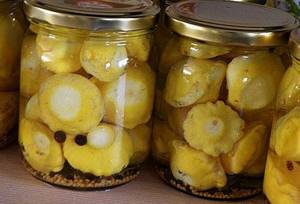
The very shape of the squash makes it very convenient to stuff . You can choose the filling for the minced meat according to your taste. It can be minced meat with rice, pieces of meat with fried onions.

Fans of vegetarian dishes can replace the minced meat with a mushroom filling with fried onions. Stewed vegetables (onions, carrots, cabbage, tomatoes, eggplants) can be a good alternative to meat.
Contraindications and harm to squash
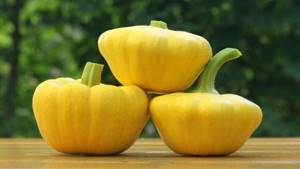
Despite the beneficial properties of squash and a bunch of vitamins, the use of this product is not recommended in some cases:
- The vegetable is strictly forbidden to be consumed by people with diseases of the digestive tract;
- It is not recommended to consume this fruit for people with diarrhea (this can only complicate the situation);
- Doctors strongly do not recommend giving canned squash to children under ten years of age;
- People with hypotension should limit their consumption of this vegetable.
If you do not suffer from any of the above diseases, then feel free to eat this vegetable. But, like any other product, squash can be eaten in moderation to avoid allergic reactions in the body.
Stuffed squash recipe
Ingredients:
- Medium sized squash – 6 pcs.
- Minced meat – 0.5 kg.
- Ghee butter – 0.1 kg.
- Onions – 3 pcs.
- Hard cheese – 0.3 kg.
- Salt, pepper, spices - to taste.
- Fresh cilantro (or any other greens) - 1 medium bunch.
- Sour cream or cream – 0.25 kg.
At the beginning of the cooking process, you should sort out the greens and peel the onions. Then wash the meat and vegetables thoroughly. When everything is ready, you can start preparing the squash. To do this, cut off the “cap” in the place where the vegetable’s tail is located.
Then, using an ordinary tablespoon, you need to select the pulp from the vegetable so that you get something like a “pot”, which will subsequently be filled with minced meat. To prepare the filling, take a frying pan and heat 50 g of oil . Place minced meat and finely chopped onion there. Add salt and pepper to taste.
Lightly fried minced meat should be placed in “molds” prepared from squash and covered with their own “lids”. Place the stuffed vegetables on a baking sheet and pour over the remaining melted butter.
The baking sheet with filled vegetables is sent to the oven, preheated to 180-200o for 25 minutes . Then you need to remove it from the oven and sprinkle the vegetables with cheese grated on a coarse grater.
The vegetables go back into the oven for another 5-10 minutes . Ready squash can be sprinkled with finely chopped herbs and served with sour cream or cream. Those who like a spicy taste can add chopped garlic to the minced meat. Or serve the finished dish with garlic sauce.
"Pineapples" from zucchini
Ingredients: 1.5 kg of medium-sized zucchini, 1 liter of pineapple juice (it is better to choose the most expensive and natural), 250 g of sugar, 1.5 tsp. citric acid.
Preparation: peel the zucchini, cut lengthwise, remove the core with seeds and cut the pulp first into thin half rings, and then into approximately the same pieces as canned pineapples in jars. Pour pineapple juice into a saucepan, add sugar and citric acid and boil. Place the zucchini slices in the syrup and cook them over medium heat for 15–20 minutes. They should be saturated with syrup and become translucent, but not boiled. If the “pineapples” turn out too pale, you can tint them with a small pinch of turmeric. Place the finished zucchini with hot syrup into sterilized jars, then turn them upside down and slowly cool under a blanket or in a thermal bag.
Photo: Shutterstock.com
How long to cook squash - SIMPLE-TASTY
How to pickle squashProducts Squash - 1 kilogram Dill and parsley - 2-3 sprigs each Mint, bay leaf, oak and horseradish leaves - 2-3 leaves each Garlic - 2 cloves Peppercorns - 5-6 peas Water - 1 liter Salt - 2.5 tablespoons Sugar - 1 tablespoon 9% vinegar - 4 tbsp. How to pickle squash
How to salt squash What you need to pickle squash Squash - 1 kilogram Pepper - 10 peas Dill and parsley - 50 grams in total Horseradish root - 70 grams. Cinnamon - half a teaspoon Garlic - 5 cloves For brine, 1 liter of water - 80 grams of salt. How to pickle squash
| Vegetable stew with squash in a pressure cookerProducts Squash - 1 large Potatoes - 2 kilograms Carrots - 1 piece Onions - 1 head Greens - 1 bunch Water - 200 milliliters Vegetable oil - 2 tablespoons Salt and spices - depending on taste preferences. How to cook vegetable stew with squash
Vegetable stew is ready. Serve it on plates, garnished with herbs. |
prosto-vkusno.ucoz.com


